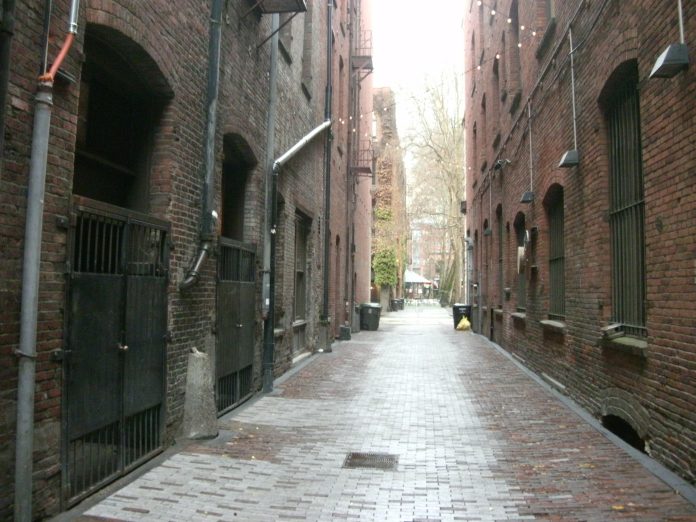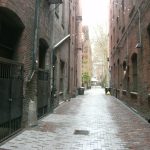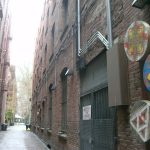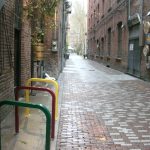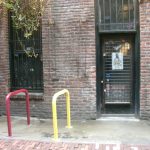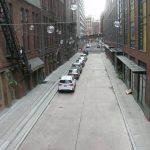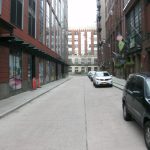Progress on active alleys continues in Pioneer Square. The Seattle Department of Transportation (SDOT) has recently wrapped up work on the next upgrade phase of Nord Alley. Pioneer Passage, a block north, remains under construction. Longer term visions suggest that Nord Alley could have canopies and other active alley features. Pioneer Passage is hoped to have outdoor seating and dining opportunities, too. SDOT also completed bridge replacement on Post Avenue, which greatly improved the pedestrian environment.
Nord Alley has long been an artsy street with murals and has been a host to monthly art walks. Cafe Nordo, a food-focused theater company that moved to the Globe Building adjacent to Nord Alley in 2015, increased the art-focused nature of the block. The streetscape improvements involved replacement of asphalt pavement with red brick and concrete. The quality of the improvement is actually quite remarkable with an old world touch. SDOT installed colorful bike racks in keeping with the eco-friendly feeling and culture of the block. Pioneer Passage is expected to have similar features. Construction was intentionally staggered after work on Nord Alley, but has been slightly delayed. Funding for both alleys comes from a variety of sources, including SDOT, Office of Economic Development, Seattle City Light, Century Link, and the federal government.
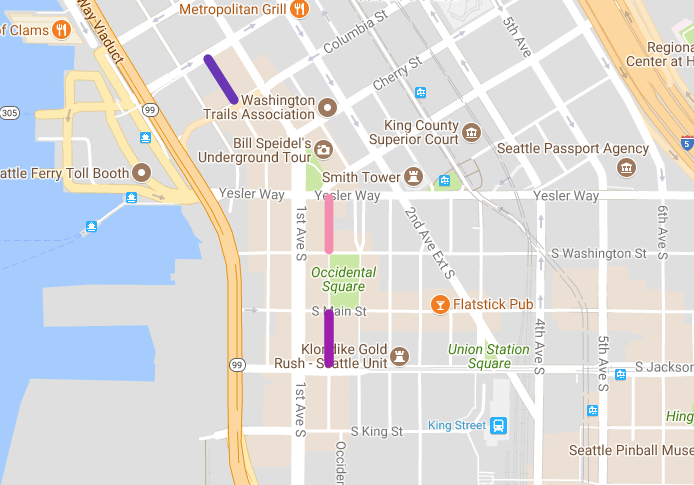
When Pioneer Passage is complete, a full pedestrian corridor from Yesler Way to Jackson Street, complete with marked crosswalks, will exist, with the direct entrances to businesses like Back Alley Bike Repair and Casco Antiguo truly creating a corridor worth using.
Separately, SDOT has worked to replaced an aging bridge structure on Post Avenue between Marion Street and Columbia Street. The structure was one of the oldest and largest timber pile bridges dating from the golden age of Seattle (1911). On the surface, the bridge appeared just as any other concrete and asphalt street. When SDOT got to work on improving the street, new concrete was poured and scored between the curbs to look like inlaid bricks. For better accessibility, SDOT also stepped curbing on the east side of the street to reduce the high curb in certain sections. Project funding, which totals approximately $2 million, comes from federal and local sources.
Overall, these projects are a huge improvement and help begin to build a network of pedestrian streets and active alleys in Pioneer Square. Post Avenue still contains some hidden potential, with on-street parking in central downtown and Pioneer Square where one only needs to look to Pike Place Market for an example of the best use for the passageway between First Avenue and Western Avenue.
Other efforts on active alleys are underway throughout the city, including projects completed last year in Chinatown and University District. These efforts undoubtedly will continue to evolve as local communities embrace their active alleys and find innovative ways to further improve them.
Activating Alleys: Canton, U District, And Pioneer Square Edition
Stephen is a professional urban planner in Puget Sound with a passion for sustainable, livable, and diverse cities. He is especially interested in how policies, regulations, and programs can promote positive outcomes for communities. With stints in great cities like Bellingham and Cork, Stephen currently lives in Seattle. He primarily covers land use and transportation issues and has been with The Urbanist since 2014.

